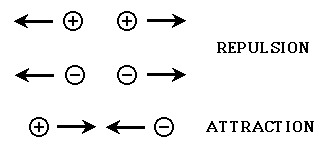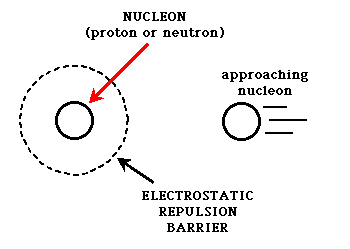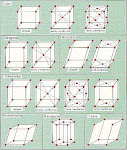This article is about the force sometimes called the residual strong force. For the "strong nuclear force" see strong interaction; for the "weak nuclear force", see weak interaction. 
The same diagram with the individual
quark constituents shown, to illustrate how the
fundamental strong interaction gives rise to the
nuclear force. Straight lines are quarks, while multi-colored loops are
gluons (the carriers of the fundamental force). Other gluons, which bind together the proton, neutron, and pion "in-flight," are not shown.
The nuclear force (or nucleon-nucleon interaction or residual strong force) is the force between two or more nucleons. It is responsible for binding of protons and neutrons into atomic nuclei. To a large extent, this force can be understood in terms of the exchange of virtual light mesons, such as the pions. Sometimes the nuclear force is called the residual strong force, in contrast to the strong interactions which are now understood to arise from quantum chromodynamics (QCD). This phrasing arose during the 1970s when QCD was being established. Before that time, the strong nuclear force referred to the inter-nucleon potential. After the verification of the quark model, strong interaction has come to mean QCD.
Since nucleons have no color charge, the nuclear force does not directly involve the force carriers of quantum chromodynamics, the gluons. However, just as electrically neutral atoms (each composed of cancelling charges) attract each other via the second-order effects of electrical polarization, via the van der Waals forces (London forces), so by analogy, "color-neutral" nucleons may attract each other by a type of polarization which allows some basically gluon-mediated effects to be carried from one color-neutral nucleon to another, via the virtual mesons which transmit the forces, and which themselves are held together by virtual gluons. It is this van der Waals-like nature which is responsible for the term "residual" in the term "residual strong force." The basic idea is that while the nucleons are "color-neutral," just as atoms are "charge-neutral," in both cases, polarization effects acting between near-by neutral particles allow a "residual" charge effect to cause net charge-mediated attraction between uncharged species, although it is necessarily of a much weaker and less direct nature than the basic forces which act internally within the particles. [1]
History
The nuclear force has been at the heart of nuclear physics ever since the field was born in 1932 with the discovery of the neutron by James Chadwick. The traditional goal of nuclear physics is to understand the properties of atomic nuclei in terms of the 'bare' interaction between pairs of nucleons, or nucleon-nucleon forces (NN forces).
In 1935, Hideki Yukawa made the earliest attempt to explain the nature of the nuclear force. According to his theory, massive bosons (mesons) mediate the interaction between two nucleons. Although, in light of QCD, meson theory is no longer perceived as fundamental, the meson-exchange concept (where hadrons are treated as elementary particles) continues to represent the best working model for a quantitative NN potential.
Historically, it was a formidable task to describe the nuclear force phenomenologically, and the first semi-empirical quantitative models came in the mid-1950s. There has been substantial progress in experiment and theory related to the nuclear force. Most basic questions were settled in the 1960s and 1970s. In recent years, experimenters have concentrated on the subtleties of the nuclear force, such as its charge dependence, the precise value of the πNN coupling constant, improved phase shift analysis, high-precision NN data, high-precision NN potentials, NN scattering at intermediate and high energies, and attempts to derive the nuclear force from QCD.
Basic properties of the nuclear force
- The nuclear force is only felt among hadrons.
- Strength of nuclear force is proportional to 1/r7[citation needed].
- At much smaller separations between nucleons the force is very powerfully repulsive, which keeps the nucleons at a certain average separation.
- Beyond about 1.3 fm separation, the force drops to negligibly small values.
- At short distances, the nuclear force is stronger than the Coulomb force; it can overcome the Coulomb repulsion of protons inside the nucleus. However, the Coulomb force between protons has a much larger range and becomes the only significant force between protons when their separation exceeds about 2.5 fm.
- The NN force is nearly independent of whether the nucleons are neutrons or protons. This property is called charge independence.
- The NN force depends on whether the spins of the nucleons are parallel or antiparallel.
- The NN force has a noncentral or tensor component. This part of the force does not conserve orbital angular momentum, which is a constant of motion under central forces.
Nucleon-nucleon potentials
Two-nucleon systems such as the deuteron as well as proton-proton or neutron-proton scattering are ideal for studying the NN force. Such systems can be described by attributing a potential (such as the Yukawa potential) to the nucleons and using the potentials in a Schrödinger equation. The form of the potential is derived phenomenologically, although for the long-range interaction, meson-exchange theories help to construct the potential. The parameters of the potential are determined by fitting to experimental data such as the deuteron binding energy or NN elastic scattering cross sections (or, equivalently in this context, so-called NN phase shifts).
The most widely used NN potentials are the Paris potential, the Argonne AV18 potential, the CD-Bonn potential and the Nijmegen potentials.
A more recent approach is to develop effective field theories for a consistent description of nucleon-nucleon and three-nucleon forces. In particular, chiral symmetry breaking can be analysed in terms of an effective field theory (called chiral perturbation theory) which allows perturbative calculations of the interactions between nucleons with pions as exchange particles.
From nucleons to nuclei
The ultimate goal of nuclear physics would be to describe all nuclear interactions from the basic interactions between nucleons. This is called the microscopic or ab initio approach of nuclear physics. There are two major obstacles to overcome before this dream can become reality:
- Calculations in many-body systems are difficult and require advanced computation techniques.
- There is evidence that three-nucleon forces (and possibly higher multi-particle interactions) play a significant role. This means that three-nucleon potentials must be included into the model.
This is an active area of research with ongoing advances in computational techniques leading to better first-principles calculations of the nuclear shell structure. Two- and three-nucleon potentials have been implemented for nuclear masses up to A=12.
Nuclear potentials
A successful way of describing nuclear interactions is to construct one potential for the whole nucleus instead of considering all its nucleon components. This is called the macroscopic approach. For example, scattering of neutrons from nuclei can be described by considering a plane wave in the potential of the nucleus, which comprises a real part and an imaginary part. This model is often called the optical model since it resembles the case of light scattered by an opaque glass sphere.
Nuclear potentials can be local or global: local potentials are limited to a narrow energy range and/or a narrow nuclear mass range, while global potentials, which have more parameters and are usually less accurate, are functions of the energy and the nuclear mass and can therefore be used in a wider range of applications.
See also
References
- ^ See Harald Fritzsch: Quarks ISBN-13: 978-0465067817 for the verbal analogy argument, from one of the original inventors of QCD theory as an explanation of nuclear physics.
- Gerald Edward Brown and A. D. Jackson, The Nucleon-Nucleon Interaction, (1976) North-Holland Publishing, Amsterdam ISBN 0-7204-0335-9
- R. Machleidt and I. Slaus, "The nucleon-nucleon interaction", J. Phys. G 27 (2001) R69 (topical review).
- Kenneth S. Krane, "Introductory Nuclear Physics", (1988) Wiley & Sons ISBN 0-471-80553-X
- P. Navrátil and W.E. Ormand, "Ab initio shell model with a genuine three-nucleon force for the p-shell nuclei", Phys. Rev. C 68, 034305 (2003).

 The nucleons must be extremely close together in order for this exchange to happen. The distance required is about the diameter of a proton or a neutron. If a proton or neutron can get closer than this distance to another nucleon, the exchange of mesons can occur, and the particles will stick to each other. If they can't get that close, the strong force is too weak to make them stick together, and other competing forces (usually the electromagnetic force) can influence the particles to move apart. This is represented in the following graphic. The dotted line surrounding the nucleon being approached represents any electrostatic repulsion that might be present due to the charges of the nucleons/particles that are involved. A particle must be able to cross this barrier in order for the strong force to "glue" the particles together.
The nucleons must be extremely close together in order for this exchange to happen. The distance required is about the diameter of a proton or a neutron. If a proton or neutron can get closer than this distance to another nucleon, the exchange of mesons can occur, and the particles will stick to each other. If they can't get that close, the strong force is too weak to make them stick together, and other competing forces (usually the electromagnetic force) can influence the particles to move apart. This is represented in the following graphic. The dotted line surrounding the nucleon being approached represents any electrostatic repulsion that might be present due to the charges of the nucleons/particles that are involved. A particle must be able to cross this barrier in order for the strong force to "glue" the particles together. 







